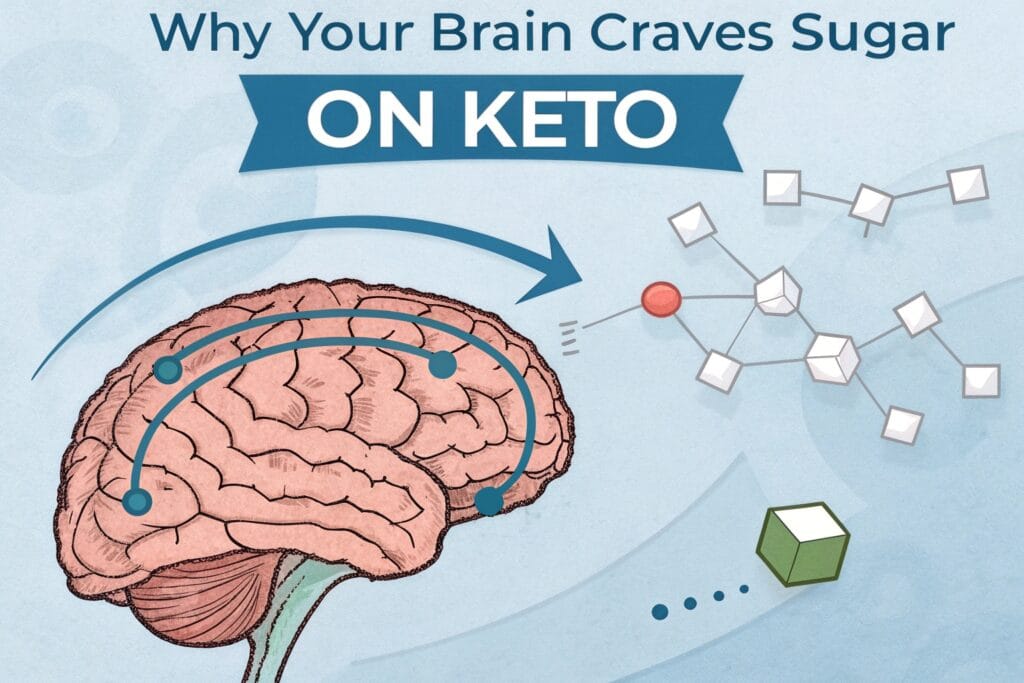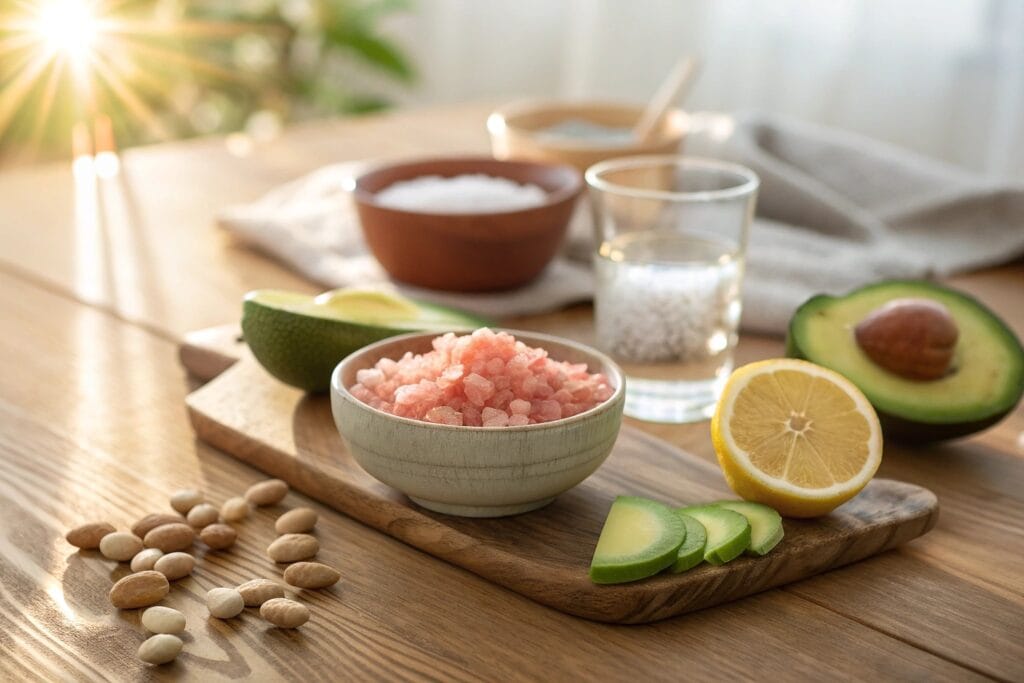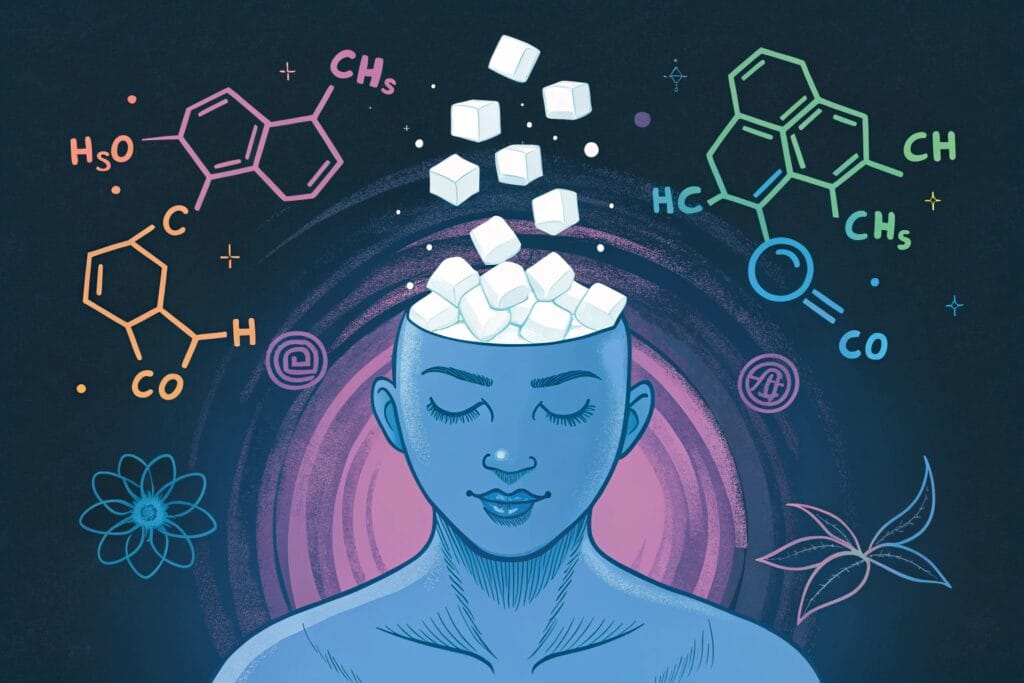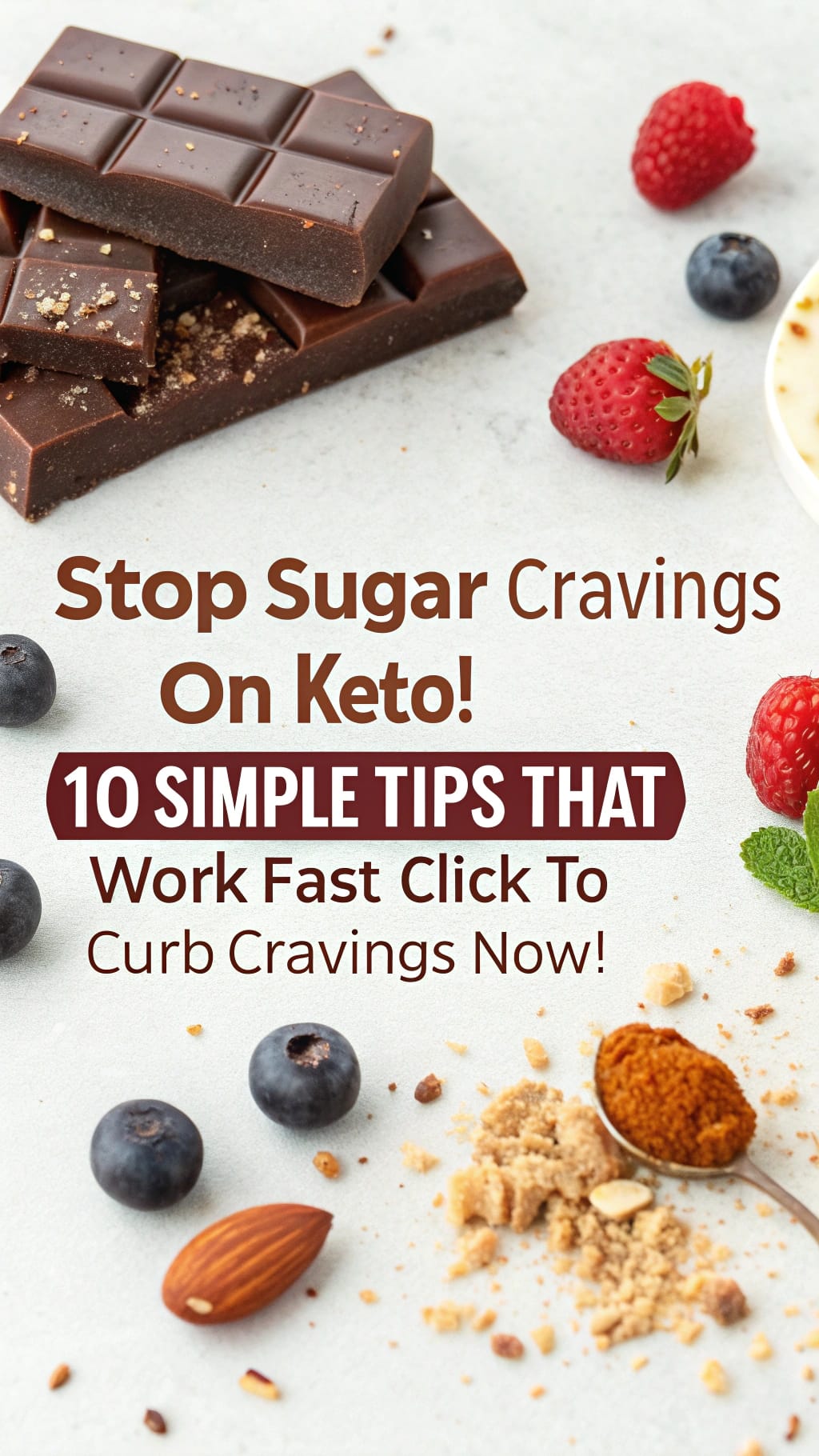How To Stop Sugar Cravings Ketosis: 10 Science-Based Solutions
Feeling Those sugar cravings ketosis Kick In on Keto?
So you’ve committed to the keto lifestyle—cutting carbs, increasing healthy fats, and watching your macros like a hawk. Yet here you are, staring at the pantry, desperately wishing for something sweet. Trust me, you’re not alone in this battle against sugar cravings ketosis.
Those nagging thoughts about cookies, ice cream, or even fruit can feel overwhelming, especially during your first few weeks on keto. It’s frustrating and confusing—you’ve eliminated sugar from your diet, so why do you suddenly want it more than ever?
Table of Contents
Good News: You CAN Beat Keto Sugar Cravings!
Here’s the silver lining: these cravings aren’t permanent, and you absolutely can overcome them without derailing your ketogenic journey. This guide will walk you through exactly why those sugar cravings hit so hard on keto and provide you with 10 practical, science-backed strategies to conquer them quickly.
By understanding the root causes of your keto sweet tooth and implementing targeted solutions, you’ll be able to sail through ketosis without constantly battling those persistent sugar demons. If you’re also experiencing weight loss plateaus, check out our guide on why you’re not losing weight on keto for comprehensive solutions.

Understanding the Root Causes of Your Keto Sweet Tooth
Before jumping into solutions, it’s important to understand why sugar cravings happen in the first place. When you know what’s driving your desire for sweets, you can address the real problem rather than just treating symptoms.
Sugar Withdrawal: Your Brain’s Old Habits Die Hard
Your brain has likely been running on glucose for years, possibly decades. When you suddenly remove its primary fuel source, it protests—loudly. Sugar triggers dopamine release in your brain’s reward centers, creating pleasure pathways similar to those activated by addictive substances. When these pathways don’t get their expected “hit,” your brain sends increasingly urgent signals to get that sugar fix.
Research published in the journal Neuroscience & Biobehavioral Reviews confirms that sugar consumption activates the same reward pathways as addictive drugs, making the withdrawal process genuinely challenging [1].
Habit & Environment: Old Routines Die Hard
Many of us have deeply ingrained habits around sugar consumption. That afternoon cookie with coffee, dessert after dinner, or weekend ice cream treat become automatic behaviors over time. These habit loops can trigger cravings even when your body doesn’t physically need sugar.
According to research from Charles Duhigg in his book “The Power of Habit,” nearly 40% of our daily actions are habits rather than conscious decisions [2]. This explains why environmental cues can trigger sugar cravings so powerfully.
Not Enough Fat/Protein: Lack of Satiety
One of the most common mistakes on keto is not eating enough fat or protein. When your body isn’t properly satiated, it can misinterpret hunger signals as specific cravings for quick energy (i.e., sugar). Without sufficient nutritional intake, your body may push you toward the fastest energy source it knows.
For more on optimizing your fat intake, see our article on advantages of ketosis which explains how proper fat consumption enhances metabolic flexibility.

Electrolyte Imbalance: The Mineral Connection
Low sodium, magnesium, and potassium levels can manifest as sugar cravings. On keto, your body excretes more electrolytes than usual, and if you’re not replacing them adequately, your body might signal for sugar when it’s actually crying out for minerals.
A 2019 study in the journal Nutrients demonstrated that magnesium deficiency specifically can increase sugar cravings and disrupt glucose metabolism [3].
Hidden Carbs Sneaking In
Sometimes small amounts of hidden carbs in your diet can prevent full ketosis while simultaneously triggering more cravings. These sneaky carbs keep you in a frustrating middle ground where your body continues to expect glucose without fully adapting to fat burning.
Our guide to zero carb snacks can help you eliminate these hidden carb sources from your diet.
Dehydration: Thirst in Disguise
The signals for thirst and hunger can be surprisingly similar. When you’re dehydrated on keto (which is common during the adaptation phase), your body might send signals that you interpret as sugar cravings when you actually just need water.
Research from the University of Washington found that 37% of people mistake thirst for hunger regularly [4].
Stress & Poor Sleep: Hormonal Havoc
High cortisol from stress and poor sleep disrupts hormones that regulate hunger and satiety, particularly ghrelin and leptin. This imbalance can significantly increase cravings for quick energy sources like sugar and refined carbs.
For stress management techniques specially designed for keto dieters, check out our stress management PDF resource.
Your Toolkit to Crush Sugar Cravings on Keto
Now that you understand why these cravings occur, let’s dive into practical solutions that can help you overcome them quickly and effectively.
1. Boost Your Healthy Fat Intake
Fat is your new primary fuel source on keto, so don’t skimp on it! Increasing your healthy fat consumption helps signal satiety to your brain and provides steady energy that prevents the crashes that can trigger sugar cravings.
Try these fat-boosting strategies:
- Add a tablespoon of MCT oil to your morning coffee
- Snack on avocado with salt and lime juice
- Include fatty cuts of meat in your meals
- Don’t fear the butter on your vegetables
- Keep nuts like macadamias or pecans handy (in moderation)
For delicious high-fat meal ideas, explore our keto crockpot recipes that make fat incorporation easy and delicious.
2. Prioritize Protein
Protein is incredibly satiating and helps stabilize blood sugar levels. When you consume adequate protein, you’re less likely to experience the energy dips that trigger cravings.
Protein power moves:
- Start your day with eggs
- Keep cooked chicken, beef, or fish ready for quick meals
- Consider bone broth as a nutritious, protein-rich snack
- Aim for 0.8-1g of protein per pound of lean body mass daily
Research in the American Journal of Clinical Nutrition confirms that higher protein intake significantly reduces cravings and late-night snacking desires [5].
Our carnivore chicken recipes provide excellent high-protein options that satisfy both hunger and taste buds.
3. Hydrate, Hydrate, Hydrate!
Sometimes the simplest solution is the most effective. Drinking enough water is crucial on keto, as dehydration can mimic hunger and trigger cravings. The initial water weight loss on keto means your body needs even more hydration than usual.
Hydration tips:
- Carry a water bottle everywhere
- Add a pinch of salt and squeeze of lemon for flavor and electrolytes
- Track your intake until proper hydration becomes habit
- Aim for at least half your body weight (in pounds) in ounces of water daily
4. Get Your Electrolytes Right (Especially Salt!)
Proper electrolyte balance is non-negotiable on keto. When your body depletes glycogen stores, it sheds water and electrolytes along with it. This mineral loss can trigger various symptoms, including intense cravings.
Electrolyte essentials:
- Don’t fear salt—add it liberally to your food
- Consider an electrolyte supplement specifically formulated for keto
- Sip on bone broth for natural sodium, magnesium, and potassium
- Magnesium supplementation can be particularly helpful for craving control
For a complete guide to supplements that support ketosis, see our article on carnivore diet supplements which includes electrolyte recommendations.
5. Eat Whole, Unprocessed Keto Foods
Many “keto-friendly” packaged foods contain ingredients that can trigger cravings in sensitive individuals. Focusing on whole, unprocessed foods helps reset your palate and reduces exposure to potential craving triggers.
Whole food focus:
- Build meals around meat, fish, eggs, and low-carb vegetables
- Limit keto-friendly packaged foods, especially early in your journey
- Read labels carefully for hidden sugars and starches
- Cook at home whenever possible to control ingredients
For simple, whole-food meal ideas, check out our keto carnivore ground beef skillet recipe that emphasizes real, unprocessed ingredients.
6. Manage Your Stress
Stress is a significant driver of cravings, as high cortisol levels can increase hunger hormones and decrease willpower. Finding effective stress management techniques is crucial for long-term keto success.
Stress-busting strategies:
- Practice deep breathing or meditation for even just 5 minutes daily
- Take short walks outside to reset your mind
- Try adaptogenic herbs like ashwagandha that may help modulate stress hormones
- Set boundaries with work and technology
A 2019 study in the Journal of Health Psychology found that mindfulness practices reduced both psychological and physiological stress markers while simultaneously decreasing food cravings [6].
7. Prioritize Quality Sleep
Poor sleep disrupts hunger hormones and can increase cravings by up to 45%, according to some studies. Making sleep a priority isn’t just good for general health—it’s essential for managing keto cravings.
Sleep improvement tactics:
- Establish a consistent sleep schedule
- Create a dark, cool sleeping environment
- Avoid screens 1-2 hours before bedtime
- Consider magnesium supplementation, which may improve sleep quality
Research from the University of Chicago found that even a single night of poor sleep can increase hunger hormones and craving intensity, particularly for carbohydrate-rich foods [7].
8. Have Keto-Friendly “Treats” Ready (Use Wisely!)
Sometimes the best approach isn’t to fight cravings but to redirect them to keto-friendly alternatives. Having acceptable options ready can help you stay on track when cravings hit hard.
Keto-friendly treats:
- Berries with heavy cream (in small portions)
- Dark chocolate (85% or higher)
- Homemade fat bombs with cocoa powder
- Keto mousse made with cream cheese and cocoa
For more sweet-tooth satisfying options, check out our keto buffalo chicken dip which provides a savory alternative to sweet cravings.
Note of caution: These should be occasional tools, not daily habits. Using too many keto sweets can maintain your sweet tooth rather than helping you overcome it.

9. Identify & Change Your Habit Loops/Triggers
Pay attention to when and where your cravings typically strike. By identifying specific triggers, you can create alternative routines that don’t involve food.
Breaking the habit loop:
- If you crave sweets after dinner, try going for a walk instead
- If afternoon sugar cravings hit at work, prepare a keto-friendly snack in advance
- If watching TV triggers snacking, occupy your hands with another activity
- Replace the reward (sugar) with something else pleasurable but healthy
Research from MIT has shown that habits have three components: cue, routine, and reward. By keeping the cue and reward but changing the routine, you can effectively rewire your habit loops [8].
10. Give It Time & Be Patient
Perhaps the most important strategy is simply patience. Sugar cravings typically peak in the first 2-3 weeks of keto and diminish significantly as your body becomes fat-adapted.
Patience pointers:
- Keep a journal to track how cravings change over time
- Celebrate small victories as cravings become less frequent or intense
- Remember that each day gets easier as your body adapts
- Focus on how much better you feel overall on keto
For inspiration on the long-term benefits of sticking with keto, see our article on top carnivore diet benefits which highlights improvements many experience after the adaptation phase.
Are You Accidentally Sabotaging Yourself? Avoid These Pitfalls
Even with the best intentions, you might be making mistakes that worsen your sugar cravings on keto. Watch out for these common pitfalls:
Relying too heavily on artificial sweeteners: While technically “zero-carb,” artificial sweeteners can maintain your sweet tooth and even trigger insulin responses in some people. Use them sparingly rather than as a crutch.
Research published in the journal Cell Metabolism suggests that artificial sweeteners may actually increase sugar cravings rather than satisfy them by creating a disconnect between sweetness and calories [9].
Consuming too many “keto” products: Bars, cookies, and other processed keto foods often contain ingredients that can trigger cravings. These should be occasional conveniences, not dietary staples.
Undereating calories: Severe caloric restriction sends stress signals to your body, which can intensify cravings. Focus on nutrient density and proper satiety instead.
If you’re struggling with weight loss despite following keto correctly, our guide on why am I not losing weight on keto addresses common obstacles, including caloric intake issues.
Inconsistent meal timing: Erratic eating patterns can lead to blood sugar fluctuations that trigger cravings. Consider establishing a regular eating schedule that works for your lifestyle.
Ignoring sleep and stress: The impact of lifestyle factors on cravings cannot be overstated. If you’re only focusing on food and neglecting sleep and stress management, you’re fighting an uphill battle.
Beyond Quick Fixes: Building Lasting Freedom from Cravings
While the previous strategies provide immediate relief, building long-term resilience against sugar cravings requires a more comprehensive approach:
Focus on nutrient density: Prioritize foods rich in micronutrients to ensure your body’s true nutritional needs are met. Often, cravings diminish when nutritional gaps are filled.
For brain-supporting nutrients that also help with cravings, explore our guide to 10 keto carnivore brain foods.
Develop metabolic flexibility: Gradually, your body becomes more efficient at switching between fuel sources. This metabolic flexibility reduces the intensity of cravings when carb intake occasionally fluctuates.
Cultivate mindful eating: Pay attention to hunger signals, eat slowly, and savor your food. Mindfulness helps distinguish between true hunger and habitual cravings.
Find joy beyond food: Develop sources of pleasure and satisfaction that don’t involve eating. Hobbies, socializing, physical activity, and creative pursuits can provide the dopamine hit you once got from sugar.
Frequently Asked Questions About Keto Sugar Cravings
How long do sugar cravings last on keto?
For most people, the intensity of sugar cravings peaks during the first 1-3 weeks on keto. After this initial adaptation period, cravings typically decrease significantly as your body becomes more efficient at burning fat for fuel. However, individual experiences vary based on previous diet, metabolic health, and how strictly you follow the ketogenic diet.
Can I use sweeteners like stevia or erythritol on keto?
Natural sweeteners like stevia, erythritol, and monk fruit are technically keto-compatible as they don’t significantly impact blood sugar or insulin levels. However, they may perpetuate your taste for sweetness, making it harder to overcome sugar cravings long-term. It’s best to use them sparingly, especially in the early stages of keto adaptation.
Will fruit satisfy my sugar cravings on keto?
Most fruits are too high in carbs for standard ketogenic diets. However, small portions of berries (strawberries, raspberries, blackberries) can be incorporated in moderation once you’re fat-adapted. Be cautious with fruit in the early stages as even natural sugars can trigger cravings and disrupt ketosis.
Does intermittent fasting help with sugar cravings?
Many people find that intermittent fasting helps reduce sugar cravings by stabilizing blood sugar and insulin levels. Our guide to carnivore diet and intermittent fasting explores this synergistic approach in detail. However, fasting might initially intensify cravings before ultimately helping resolve them.
What vitamins or supplements can help reduce sugar cravings?
Several nutrients may help reduce sugar cravings:
- Magnesium: Often depleted on keto and crucial for over 300 biochemical reactions
- Chromium: Helps regulate blood sugar and may reduce carb cravings
- B vitamins: Support energy production and stress management
- Zinc: Plays a role in taste perception and appetite regulation
Always consult with a healthcare provider before adding supplements to your regimen.
Take Control of Your Keto Journey
Conquering sugar cravings on keto is a process, not an overnight fix. The good news is that each day gets easier as your body adapts to using fat for fuel.
Remember the main causes of your cravings:
- Sugar withdrawal and dopamine pathways
- Habitual patterns and environmental triggers
- Nutritional gaps (especially fat, protein, and electrolytes)
- Hydration status
- Stress and sleep quality
By addressing these factors systematically with the strategies we’ve covered, you’ll find yourself naturally desiring sweet foods less frequently and less intensely.
Most importantly, be kind to yourself during this transition. Cravings don’t represent weakness—they’re simply your body’s adaptive response to a major dietary shift. With time, patience, and the right approach, you’ll find yourself wondering why you ever felt so controlled by sugar in the first place.
What’s YOUR best tip for beating keto sugar cravings? Share it in the comments below!
New to Keto? Check out our Beginner’s Guide to the Ketogenic Diet for everything you need to know to get started.
Looking for delicious recipes to keep you satisfied on keto? Browse our Keto Recipe Collection for inspiration.
References
[1] DiNicolantonio, J. J., O’Keefe, J. H., & Wilson, W. L. (2018). Sugar addiction: is it real? A narrative review. Neuroscience & Biobehavioral Reviews, 92, 223-238.
[2] Duhigg, C. (2012). The Power of Habit: Why We Do What We Do in Life and Business. Random House.
[3] Volpe, S. L. (2019). Magnesium in Disease Prevention and Overall Health. Nutrients, 11(9), 2157.
[4] McKiernan, F., Houchins, J. A., & Mattes, R. D. (2008). Relationships between human thirst, hunger, drinking, and feeding. Physiology & Behavior, 94(5), 700-708.
[5] Leidy, H. J., Tang, M., Armstrong, C. L., Martin, C. B., & Campbell, W. W. (2011). The effects of consuming frequent, higher protein meals on appetite and satiety during weight loss in overweight/obese men. American Journal of Clinical Nutrition, 93(2), 284-291.
[6] Mason, A. E., Epel, E. S., Aschbacher, K., Lustig, R. H., Acree, M., Kristeller, J., & Daubenmier, J. (2016). Reduced reward-driven eating accounts for the impact of a mindfulness-based diet and exercise intervention on weight loss: Data from the SHINE randomized controlled trial. Journal of Health Psychology, 33(1), 78-90.
[7] Greer, S. M., Goldstein, A. N., & Walker, M. P. (2013). The impact of sleep deprivation on food desire in the human brain. Nature Communications, 4, 2259.
[8] Graybiel, A. M., & Smith, K. S. (2014). Good habits, bad habits. Scientific American, 310(6), 38-43.
[9] Suez, J., Korem, T., Zilberman-Schapira, G., Segal, E., & Elinav, E. (2015). Non-caloric artificial sweeteners and the microbiome: findings and challenges. Cell Metabolism, 17(5), 406-417.
Enjoy, Review – We Value Your Opinion!
There are no reviews yet. Be the first one to write one.

